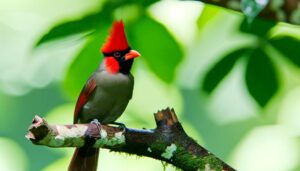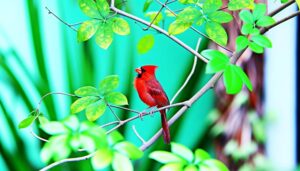There Are Cardinals in Hawaii – A Birdwatcher’s Guide
Yes, there are cardinals in Hawaii. Especially, the Northern Cardinal (Cardinalis cardinalis) and the Red-crested Cardinal (Paroaria coronata) inhabit the islands.
The Northern Cardinal, introduced in the 1920s, displays marked sexual dimorphism with males exhibiting vibrant red plumage. The Red-crested Cardinal is recognized by its striking red head and white underparts.
These species have adapted to Hawaii's diverse habitats, ranging from coastal areas to higher elevations. Their presence provides a unique ecological dynamic and impacts native bird populations such as the Hawaiian Honeycreepers.
Further insights into their behaviors and impacts are fascinating for ornithologists and bird enthusiasts alike.

Key Takeaways
- Northern Cardinals were introduced to Hawaii in the 1920s.
- They have adapted well to diverse habitats across the Hawaiian islands.
- Both Northern Cardinals and Red-crested Cardinals can be found in Hawaii.
- These cardinals exhibit marked sexual dimorphism and vibrant plumage.
- Cardinals in Hawaii impact native bird populations through resource competition.
Cardinal Species in Hawaii
In Hawaii, the cardinal species primarily observed are the Northern Cardinal (Cardinalis cardinalis) and the Red-crested Cardinal (Paroaria coronata).
The Northern Cardinal, belonging to the family Cardinalidae, is noted for its vibrant red plumage in males and its distinct crest. Females, in contrast, exhibit a more subdued brownish coloration with red tinges.
The Red-crested Cardinal, although not a true cardinal, falls under the family Thraupidae. This species is characterized by a striking red head, white underparts, and grayish wings.
Both species exhibit marked sexual dimorphism and are easily distinguishable by their unique colorations and vocalizations.
Observations indicate that these birds adapt well to Hawaii's diverse habitats, from coastal regions to higher elevations.
History of Introduction
The Northern Cardinal (Cardinalis cardinalis) was first introduced to Hawaii in the 1920s, with initial populations established on Oahu and subsequently expanding to other islands.
Factors contributing to their population growth include their adaptability to diverse habitats and the absence of natural predators.
The introduction and subsequent proliferation of these avian species provide a unique case study in ecological dynamics and species interaction within the Hawaiian archipelago.
Arrival and Early Years
Although native to North America, *Cardinalis cardinalis* was intentionally introduced to Hawaii in the late 1920s as part of an effort to diversify the islands' avian population. The species' arrival marked a significant event, given its striking plumage and distinctive song. Early observations indicated several adaptations and behaviors that facilitated their establishment on the islands.
- Initial Release Sites: Cardinals were released in various locations, including Oahu and Kauai, where they quickly adapted to the local flora.
- Dietary Adaptations: They exhibited flexibility in their diet, consuming a variety of seeds, fruits, and insects.
- Breeding: Breeding pairs were observed nesting in both native and introduced vegetation, showcasing their ecological versatility.
These early years set the stage for the cardinal's eventual proliferation across the Hawaiian archipelago.
Population Growth Factors
What factors contributed to the robust population growth of *Cardinalis cardinalis* following its introduction to the Hawaiian Islands in the late 1920s? Several key elements underpin this expansion.
In the first place, the absence of natural predators in Hawaii allowed the cardinal population to flourish unimpeded.
Next, the diverse and abundant flora provided ample food resources, including seeds, fruits, and insects, essential for dietary sustenance.
Additionally, the adaptability of *C. cardinalis* to various habitats, from lowland forests to urban areas, facilitated widespread colonization.
Finally, the relatively mild Hawaiian climate promoted year-round breeding opportunities, further accelerating population growth.
These factors collectively contributed to the establishment and proliferation of *Cardinalis cardinalis* in the Hawaiian archipelago.
Cardinal Habitats
Cardinalis cardinalis, commonly known as the Northern Cardinal, exhibits a strong preference for habitats featuring dense shrubbery and forested areas, which provide essential cover and foraging grounds.
Detailed observations indicate that these birds favor edge habitats where wooded areas meet open spaces, offering a diverse array of food resources and nesting sites.
Nesting preferences include constructing nests in well-concealed locations within dense foliage, often utilizing trees and shrubs that provide ideal protection from predators and environmental elements.
Preferred Living Environments
Cardinals in Hawaii mainly inhabit areas characterized by dense greenery and abundant foliage, which provide vital cover and nesting sites. These environments support their survival and reproductive success by offering protection from predators and challenging weather conditions.
The Northern Cardinal (Cardinalis cardinalis) and the Red-crested Cardinal (Paroaria coronata) are particularly adaptable to these habitats due to their flexible foraging and nesting behaviors.
Key habitat characteristics include:
- Lush vegetation: Cardinals prefer areas with dense, layered greenery which offers plenty of hiding spots.
- Water sources: Proximity to water bodies such as streams or ponds ensures an ideal supply of hydration and food.
- Diverse plant species: A variety of plants provides a rich supply of insects, seeds, and fruits, essential for their diet.
These elements together create an optimal living environment for cardinals in Hawaii.
Nesting Preferences
Understanding their preferred living environments, it is evident that both the Northern Cardinal (Cardinalis cardinalis) and the Red-crested Cardinal (Paroaria coronata) exhibit specific nesting behaviors that optimize their reproductive success in Hawaii's diverse habitats.
Northern Cardinals typically select dense shrubbery or low tree branches, constructing cup-shaped nests from twigs, grass, and bark. Conversely, Red-crested Cardinals show a preference for nesting in tree forks or bushes, utilizing similar materials.
Both species demonstrate flexibility in their choice of nesting sites, adapting to available vegetation. This adaptability enhances their survival and proliferation in various Hawaiian ecosystems, from coastal areas to upland forests.
Such nesting strategies indicate a significant ecological plasticity, allowing both species to thrive in non-native environments.
Behavior and Diet
The Northern Cardinal (Cardinalis cardinalis), introduced to Hawaii in the early 20th century, exhibits a diverse diet primarily consisting of seeds, fruits, and insects. This omnivorous diet allows the species to adapt to various environments, from forest edges to urban gardens. Observational studies indicate their feeding habits contribute to seed dispersal and pest control within these ecosystems.
Seeds from native and introduced plants, various fruit species, and a range of insects.
The species engages in ground foraging and low-level shrub exploration to access food resources, with a preference for areas offering dense vegetation and abundant food sources. This foraging behavior and habitat preference highlight the Northern Cardinal's ecological impact and adaptability.
Breeding Patterns
During the breeding season, Northern Cardinals (Cardinalis cardinalis) in Hawaii exhibit monogamous pair bonds, with both sexes participating in nest building and rearing of the young.
These birds typically select dense shrubbery or low tree branches to construct their nests, utilizing twigs, grass, and leaves as primary materials.
Clutch sizes generally range from 2 to 5 eggs, which are incubated primarily by the female for approximately 11 to 13 days. Both parents engage in feeding the hatchlings, which fledge about 9 to 11 days post-hatching.
Northern Cardinals may produce multiple broods per breeding season, thereby enhancing their reproductive success. The cooperative parental care observed ensures higher survival rates of the offspring, aligning with their life history strategy.
Impact on Native Birds
Introduced Northern Cardinals (Cardinalis cardinalis) in Hawaii have been observed to impact native bird populations through competition for resources and potential displacement from preferred habitats. These impacts are significant, given the unique avian biodiversity of the Hawaiian archipelago.
Detailed observations indicate that Northern Cardinals compete with native species such as the Hawaiian Honeycreepers (Drepanidinae) for food resources, including insects and fruit.
Resource Competition: Northern Cardinals exploit similar dietary niches, reducing food availability for native species.
Habitat Displacement: Aggressive behaviors have led to the displacement of native birds from critical habitats.
Breeding Interference: Cardinals may interfere with the nesting sites of native species, further exacerbating the pressures on already vulnerable populations.
Such interactions necessitate detailed ecological studies to understand the full extent of their impact.
Conservation Efforts
Mitigating the negative impacts of Northern Cardinals on Hawaii's native bird populations necessitates targeted conservation efforts informed by rigorous ecological research.
Cardinalis cardinalis, although visually striking, poses challenges to endemic avifauna like the Hawaiian Honeycreepers (Drepanidinae).
Effective strategies include habitat restoration, eradication of invasive plant species that provide resources for cardinals, and the enhancement of native flora.
Monitoring cardinal populations through banding and tracking enables precise data collection, aiding in adaptive management.
Collaborations among local conservation organizations, academic institutions, and government agencies ensure a multidisciplinary approach.
Public education programs further bolster conservation by fostering community engagement and awareness.
Through these concerted efforts, the delicate balance of Hawaii's unique ecosystems can be more effectively preserved.
Birdwatching Tips
While conservation efforts to manage Northern Cardinals in Hawaii are essential, birdwatching enthusiasts can still appreciate these vibrant avians by employing informed techniques for ideal observation.
The Northern Cardinal (*Cardinalis cardinalis*), recognized by its vivid red plumage and distinct crest, frequents diverse habitats, including urban parks and forested regions.
For best birdwatching experiences, consider the following strategies:
- Early Morning Excursions: Cardinals are most active during dawn, providing ample opportunities for sighting and auditory identification.
- Quiet Approach: Minimize noise and movement to prevent startling these birds, enhancing the chances of prolonged observation.
- Binoculars and Field Guides: Utilize high-quality binoculars and detailed avian field guides to accurately identify and document cardinal behavior and characteristics.
Conclusion
The introduction of cardinal species to Hawaii represents a cataclysmic shift in the avian ecosystem. These birds, with their vivid plumage and distinctive behaviors, have dramatically altered local habitats and native bird populations.
The Pyrrhuloxia and Northern Cardinal have integrated into Hawaiian landscapes with an almost preternatural ease, challenging conservationists to unprecedented lengths. Future efforts must be Herculean to mitigate their impact and preserve endemic species.
The avian tapestry of Hawaii has been irrevocably transformed.






